
 Just hanging around
Just hanging around

 Vigan, Baguio and Sagada, Philippines
Vigan, Baguio and Sagada, Philippines

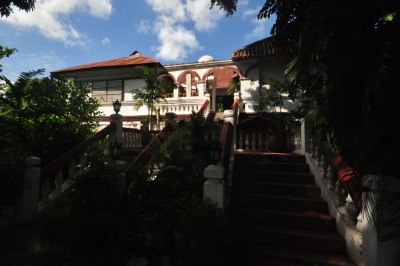
Welcoming Villa Angela. |
With no volcano to climb we were back on a bus today. Next stop, Vigan! Vigan is a World Heritage Site in that it is one of the few Hispanic towns left in the Philippines. Miraculously spared bombing in WWII, the city is considered the finest surviving example of a Spanish colonial town in Asia. It boasts cobblestone streets and a unique architecture mix of Philippine, Oriental and colonial European. I love old crumbling buildings and couldn’t wait to check Vigan out.
The bus ride was beautiful. The road skirted the coast and every now and then we’d get a peek at the ocean. We also went through a number of small towns that had Spanish characteristics. Churches painted vibrant colors sitting proudly in front of leafy main squares. Everything was lit up with bright lights and lanterns. Street names and town names all sounded Spanish as well. The Philippines have been occupied by the Spanish, Japanese and Americans but it feels like the Spanish stuck the most.
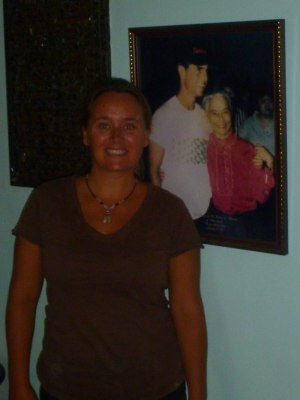
Did I sleep where Tom Cruise slept? |
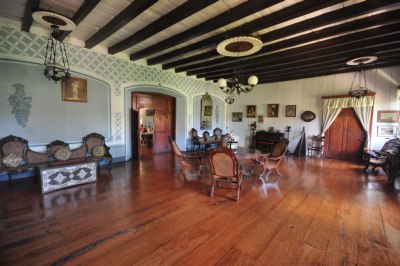 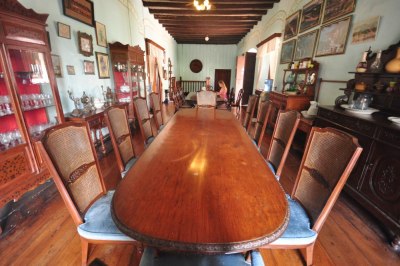
Not a bad place to sit and blog. |
I lingered after breakfast to enjoy a second cup of coffee in the grand dining room of Hotel Angeles. The sun was shining through the floor to ceiling windows and bouncing off the shiny wooden furniture and floors. There were family photos covering the walls and it was easy to daydream about what it was like back in the day.
There isn’t really any one big thing to see in Vigan. I had come to see the beautiful old buildings and churches and the town was small enough to do on foot. We picked a few spots out on the Lonely Planet map and set out. The first thing we came to was the local market. We went in for a peek. Villa Angela has beautiful hand woven towels that we were told we could buy around town so the market seemed like a good idea. It was huge, hot and smelly so we moved on. We walked by the impressive 50m-long kiln at RG Jar factory which was made in 1823 and can hold almost 1000 jars.
Next we came to the St Paul Cathedral. It was gorgeous. A very loud tour guide was pointing out all the different influences the Japanese, Chinese and Spanish had on the building. Mass was on and we didn’t want to intrude so we just poked our heads in for a quick look.
Down the street we came to Syquia Mansion that has recently been turned into a museum dedicated to Elipidio Quirino, the Philippines sixth president. I had to smile at the young girls working the donation box. They were playing ball across a table older than me and when one of them missed the catch it would bounce around the room off glass curious full of trinkets and antiques. The place was full of priceless artifacts that I’m sure they thought of as dusty old junk.
The whole time we’d been walking we’d passed beautiful buildings and we wondered what the difference was between the ones labelled “preserved” and the ones just standing there. I think the sign means you can charge an entrance fee. Regardless the architecture was worth the detour and lengthy bus ride to get here.
We eventually came to Crisologo Street that reminded me of old Montreal. It was a pedestrian street only (except for the horse carts) filled with shops and cafes. I was in heaven, James was in Hell. At the end of the street we got a culture shock. It was an outdoor mall full of brand name stores, fast food and packed with people. Weird. We walked over to the main square and couldn’t help but comment that we could be in any town in Nicaragua or Honduras. It really had a Spanish flavour to it.
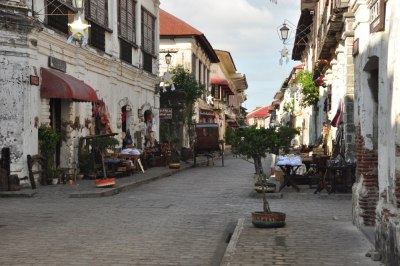
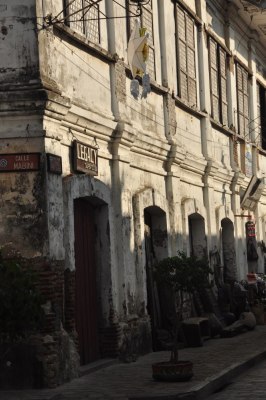
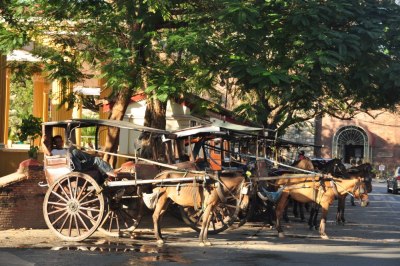
Shopping on Crisologo Street, beautiful old buildings and the Spanish flavored main square.
Our tour took us past a few more old homes and then finally to Villa Angela. It was dark by the time we got back and the house was closed up for the night. We could still get in and get around but it meant unlocking huge wooden doors with old bar locks. It was a bit creepy to be wandering around the creaky old house. Our bathroom (considered private) was out the front door, through the old kitchen, outside again and on the patio. It was a long, and dark, way to go in the middle of night that’s for sure.
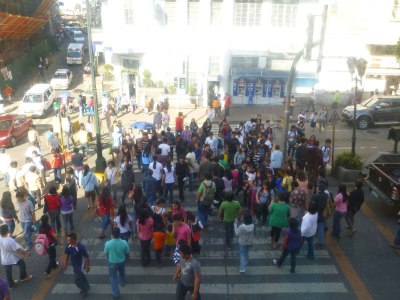
Busy Baguio. |
And back on a bus…to Baguio today! Baguio was originally constructed as a mountain retreat by the US military in the early 1900’s. Today it’s still a cool escape from Manila’s heat but also home to over a quarter of a million college students. For us it was an overnight stop to break up bus rides. We arrived late afternoon and started walking to our hotel. We got about a block away and James stopped. Do you notice we have booked into the sketchiest place we’ve seen since arriving? I think we’d somehow managed to find the dirtiest place in Baguio and booked it. We were standing right beside a hotel that looked much better than ours so went in to price it. After chatting with the manager, who just happened to be on the front desk, she pretty much matched our other price and gave us free breakfast. Sold! We dropped our bags and went for a walk; we might as well see the city if we are here.
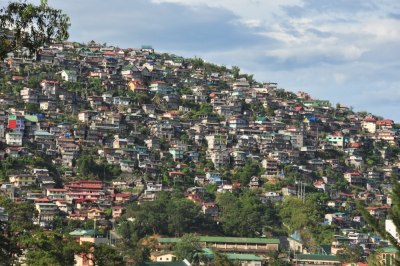
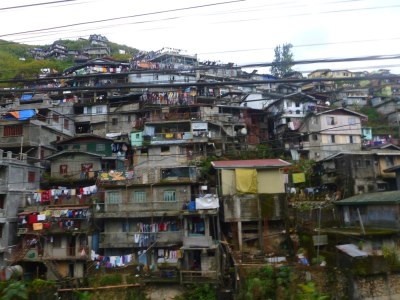
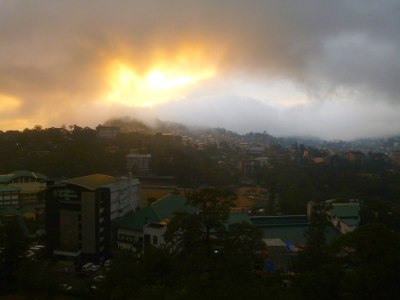
Lots of Baguio
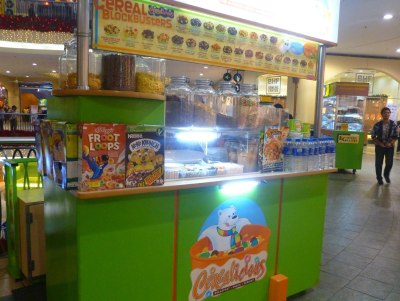
James' future career path. |
James may have found his favorite thing ever. A cereal stand. He’s decided to give up his career as an engineer to open a cereal stand in a mall. It was like a sundae stand but had different kinds of cereal and toppings. He is still talking about all the possible toppings his stand will have.
During a lull in the rain we walked back to our hotel and called it a night.
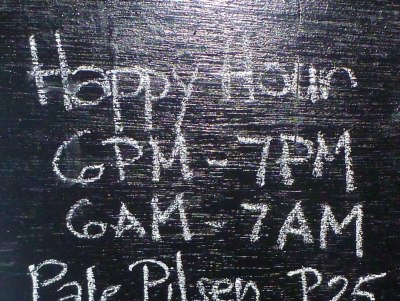
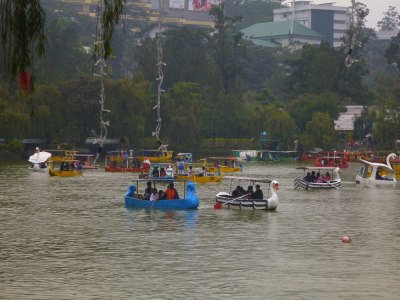
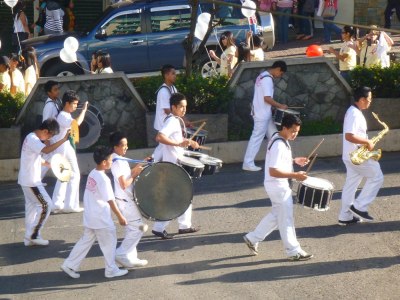
A Happy Hour I could get use to, boats I didn't get to ride and a breakfast parade.
December 2
During breakfast a parade went by and I asked the server what it was for. She wasn't sure and told us parades happen almost every day in Baguio. I love this place! After breakfast we made the short walk to the bus station. We were bound for a small town called Sagada. Sagada is a popular tourist stop with its cooler temperatures, beautiful hikes and the famous Sugong Coffins. The bus was a little worse for wear but the ride was amazing. We went inland up into the mountains and caught our first glimpse of the rice terraces; well I would call them garden terraces because they had cabbages, green onions, beans, tomatoes and even colorful flowers. It was stunning. I’ve seen my fair share of rice terraces (and rice fields) but this truly wowed me. They were bigger and up higher mountains than I’d ever seen. It’s said that in some areas they’ve been cultivating them for over 2000 years. It shows. The other truly amazing thing was the amount of space on the mountains not farmed. I had no idea the mountains in Northern Philippines were so vast.
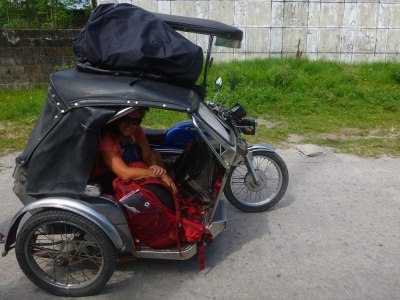
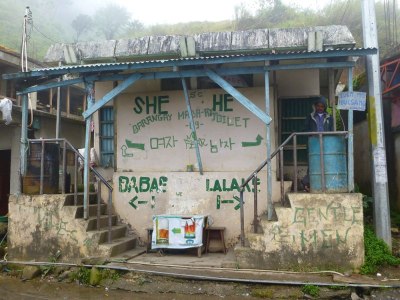
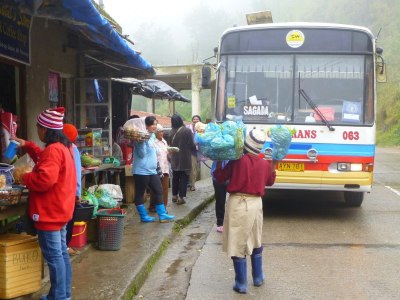
Can you see James squeezed in there with me? And a bathroom break, yuk!
It started to rain, then pour, so by the time we pulled into Sagada it was a full on storm. We looked at one or two guest houses and picked the busiest and cheapest. It wasn’t fancy but clean and comfortable. As usual, we dropped our bags and went looking for food. We also stopped at the tourism centre where everyone visiting is supposed to register and book guides. They encourage guides to protect the area from vandalism. We figure if they didn’t insist on guides they’d just have entrance fees, at least this way we get a guide to tell us a bit about the area.
Other than hiking and the caves there isn’t much to do in Sagada so after an early dinner we just headed back to the guest house. Sagada, like many northern towns, also has an early curfew. It’s mostly to do with keeping the crime rate down but we think it also has to do with the lack of power. Without power at night it’s pretty dark, if I lived here I end up just going to bed early and getting up with the sun.
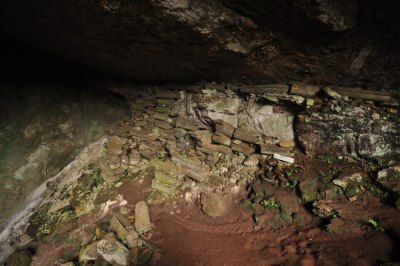 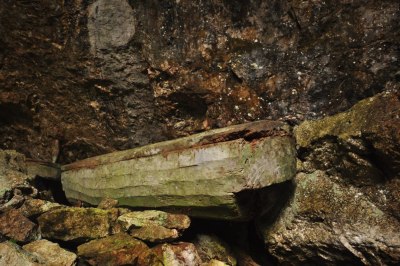
Sugong Coffins |
Our alarm went off at 7 am. I moaned and groaned. I’d had the worst sleep. James suggested we do our walking tour today (that we could start later in the morning) and do the guided your (that was supposed to start at 8 am) tomorrow. I agreed, rolled over and fell back asleep.
A few hours later I woke up to find James reading the Lonely Planet with that worry wrinkle on his forehead. The one that means something is up, and not always good. When I went back to sleep he started reading the LP and found we’d missed doing a cool hike just outside Baguio that had mummies in a cave. If we decided to do it we’d have to back track and travel a bit faster, or skip something. Never ones to pass up mummies we rearranged our plans. We decided to give up the trek through the cave and just do the entrances where the hanging coffins were and a hike where more were on cliffs. So we got up and went looking for a guide.
To get a guide we just went to the tourism office where they hang out. It’s only costs about $10 a day for an English speaking guide. A few minutes into the walk we came upon three dogs. They came up to our guide, he gave them a kick and they scurried away. A few minutes later three more dogs approached us and he allowed them to follow us. They were his dogs I think. We remarked that there were a lot of stray dogs in northern Philippines and he said they weren’t strays. They were food. Huh? He explained they were like the chickens and goats and pigs roaming around; food. I asked if any were pets. He said yes but only the pure bread dogs. Pretty much all the dogs we see are being raised as food. If you want to buy a dog, like a chicken, you just approach your neighbour and ask how much. Or if you have extras of your own you can sell them. I’m not sure why but this seems wrong to me. I’m okay with chickens (I don’t even like the mean things) but not dogs. Our guide says he just doesn’t think of them as pets.
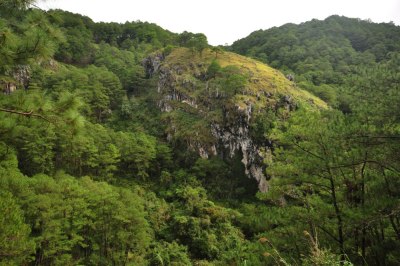 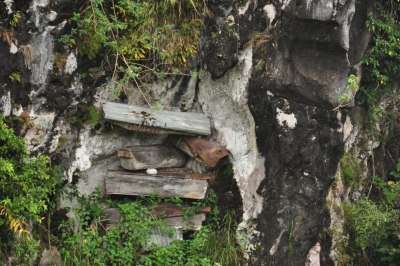
A beautiful view for the hanging coffins. |
We eventually came to a path and followed it to Lumiang Burial Cave. In the mouth there were over a hundred coffins stacked haphazardly, the oldest believed to be about 500 years old. The coffins are shorter and thicker because people are tied in a fetal position after death. Well first they are propped up in a chair and left at the front door for family and friends to come pay their final respects. I guess the same way we’d do a wake. Once in the coffin, one or two people carry it to the mouth of the cave, or the cliff. They believe in all kinds of omens and often the coffin is moved, meaning families may not be together. For example if they see a snake while carrying the coffin it’s considered a bad omen and it will be moved. Most coffins, especially in the old days, are unmarked and it’s not customary to visit. They light candles on all saints day, but it’s just at the mouth of the cave, or near the cliff, not on or at a particular coffin. The coffins are made of wood and in time rot and fall apart. Some coffins also slip down into the caves or off the side of cliffs. If this happens they just leave it, bones and all.
This custom is only done in this area (although something similar is done is a town nearby) and the Catholic Church in the area has somehow managed to blend the old traditions with the catholic religion. Most people are now being buried in the cemetery but a few times a year someone gets hung from a cliff.
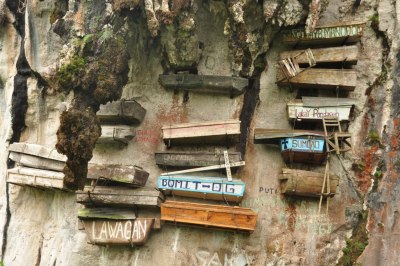
Sometimes the wake chair is hung with the coffin. More recent coffins have names. |
This was the end of our tour so we took a slow walk through the Saturday market. It was a bit boring as markets go and had a lot of used clothing and tools. The afternoon rain eventually started so we went back to our guesthouse and watched tv in the common room. Like I said before, the place wasn’t’ fancy but was clean so when I went to the shared bathroom and found that someone had cleaned their muddy shoes and left the room covered in mud I was pissed. The place was family run and really cheap ($5 CAD /person /night) and it is frustrating when someone is so disrespectful. I went looking for the person but I think they checked out after cleaning up. The bathrooms were cleaned in the mornings so it meant the rest of us had to use a mud filled shower/bathroom the rest of the day. So rude!
James and I bravely (we are both afraid of stray dogs) went out for dinner after dark. The place was packed, had great food and cheap beer. If you had some time to hang out Sagada would be a perfect spot.


